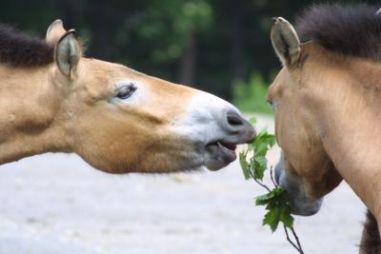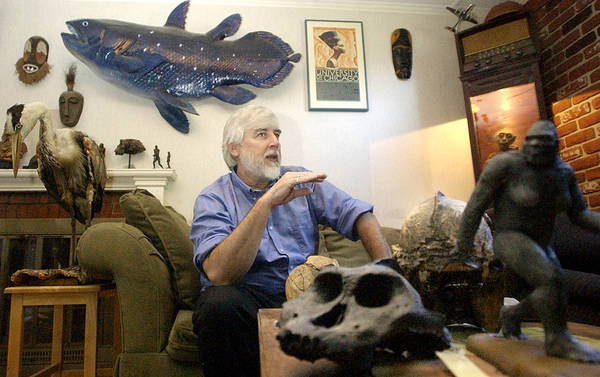Replica Cryptia: Przewalski’s Horses
Posted by: Loren Coleman on November 12th, 2007

The Przewalski’s horse, a Pleistocene megafauna survivor, can be called a “living fossil,” in the popularized employment of that phrase. Certainly, this horse is of interest to cryptozoologists. In the society we live in, this is an animal your daughter may know more about than you do.
The species (Equus ferus przewalskii, Equus caballus przewalskii, or Equus przewalski poliakov – classification is debated) is the last truly wild horse, first recognized by zoology in Mongolia in 1881.
It is an animal of discovery, with lessons to teach in cryptozoology. Besides, the Przewalski’s horse story overlaps with that of the Almas. See more about it here.
As to replicas, you might be surprised to hear that good representations of this horse have been produced for some time. But don’t look for them in the “dinosaurs” and “prehistoric animals” sections of the museums, toy stores, and craft outlets. These replicas have been hiding over in the “girls’ toys” aisles, along with all those other horse models.
Could this be the source of why some young women turn to cryptozoology? There are hints right there in their horse collections.
Two companies, Bullyland and Schleich, make good replicas of wild horses.
Bullyland produces a model that nearly looks like a Przewalski’s horse, which is called their Prehistoric Ancient Horse. It is 6″ long, shown above from The Dinosaur Farm.
To clarify, this is the Miocene fossil horse Anchitherium.

It is seen (above) in this view from Link and Pin Hobbies site.

The Schleich Przewalski’s Horse is a beauty to behold. It shows great detail and is 4″ long. This variety is infrequently found in the better “horse collections” at some toy stores; the replica here is from Healthstones’ Hobbies.
If you have a daughter or a son, now you know what to sneak into their stockings for a little cryptozoological learning.
In this series, see also:
and
Replica Cryptia: Giant Ground Sloths.
+++
Appreciation to The Dinosaur Farm, Healthstones’ Hobbies, and Link and Pin Hobbies for the information and images of today’s replicas. If you decide to shop with them, let them know that you heard about their replicas from Cryptomundo, so they understand the impact of cryptozoology and continue to supply these replicas. (No financial benefit for me is obtained from such a referral, btw. I like to write my critiques without such bias.)
This writer and the museum, instead, are supported by the kindness of readers such as yourself. Please donate to the International Cryptozoology Museum by sending your financial gifts, unwanted or extra replica animals, and/or cryptozoology artifacts to Loren Coleman, Director, ICM, PO Box 360, Portland, ME 04112, or send any fiscal contributions via PayPal to LColeman@maine.rr.com
Thank you.

Photo by Amber Waterman.
About Loren Coleman
Loren Coleman is one of the world’s leading cryptozoologists, some say “the” leading living cryptozoologist. Certainly, he is acknowledged as the current living American researcher and writer who has most popularized cryptozoology in the late 20th and early 21st centuries.
Starting his fieldwork and investigations in 1960, after traveling and trekking extensively in pursuit of cryptozoological mysteries, Coleman began writing to share his experiences in 1969. An honorary member of Ivan T. Sanderson’s Society for the Investigation of the Unexplained in the 1970s, Coleman has been bestowed with similar honorary memberships of the North Idaho College Cryptozoology Club in 1983, and in subsequent years, that of the British Columbia Scientific Cryptozoology Club, CryptoSafari International, and other international organizations. He was also a Life Member and Benefactor of the International Society of Cryptozoology (now-defunct).
Loren Coleman’s daily blog, as a member of the Cryptomundo Team, served as an ongoing avenue of communication for the ever-growing body of cryptozoo news from 2005 through 2013. He returned as an infrequent contributor beginning Halloween week of 2015.
Coleman is the founder in 2003, and current director of the International Cryptozoology Museum in Portland, Maine.










They have a pair of those here at the Pueblo Zoo. As many times as we have went I never knew the horses went that far back in history. Maybe I should pay more attention to the little informative signs at the zoo.
There’s a herd of them at the Minnesota Zoo in Dakota County.
I once worked for a guy who had a couple Dala horses, nearly identical to the Prszewalski horses, but from Scandinavia.
There are several very ancient breeds of horses (most are referred to as “ponies”), which are close to prehistoric wild horses in appearance. Some of these sturdy small horses have been bred pure for centuries, if not millennia. One which comes to mind immediately is the Fjord. Norwegian Fjord horses were already an ancient breed when the Vikings were around. They are almost certainly direct descendants of Przewalskii’s horses. Another very ancient type is the Camargue horse, which looks identical to some of the horses from ancient cave paintings from the very area of France in which it is found. They inhabit a swampy, grassy area and their skeletal features are virtually identical to the prehistoric Solutre horse, which also inhabited swampy areas near the Quanternary Sea. Then there is the Caspian Pony, which is probably a true wild species, or subspecies, and is the probable ancestor of the Arabian horse (itself a very ancient breed).
I could go on and on. There are dozens of these ancient horse breeds, and sadly, most of them are in decline. Some are near extinction now that people no longer use horses for transportation and labor over much of the world. That’s a shame, too, because most of the ancient breeds have much better temperaments and health than many overbred modern breeds
Loren, there are also some beautiful models of prehistoric horses that were produced by Breyer. I am talking about the old Breyer horses, the ones that were produced in the USA. The new ones are made in China, and they aren’t nearly as beautiful and lifelike.
A good place to visit, to see horses of dozens of breeds, from all over the world, is the Kentucky Horse Park in Lexington, KY.
Cute little critters. Thanks for the information. Definite stocking stuffer.
I’m going to the ICM as soon as I can woo hoo!! It might be a few months though.
These re-constituted populations of extinct megafauna are excellent candidates for the proposed re-introduction of keystone species which once inhabited our continent. If you haven’t checked out Josh Donlon’s “Re-wilding America” site, you will be in for a delightful surprise. Equally surprising is that there is a nascent segment of people around the world who are taking a second look at re-wilding efforts, everywhere, even in Europe. It’s been too long that we’ve accepted the received wisdom of those who say that extinction was inevitable such a short time ago. While we can’t actually turn back the hands of time, we can approximate and by use of surrogates return the more fully functional lanscape from which we derive so much of what makes us who we are.
Thanks for the very interesting article, Mr. C. This reminds of something I read recently in Smithsonian magazine, about the Bialowieza National Park on the border between Poland and Belarus. There are horses living in essentially wild conditions there, and they closely resemble the now extinct wild horse called the Tarpan, the last individual of which perished in 1887 in a Moscow zoo. The horses in Bialowieza are apprently descended from individuals that were the result of a WWII era German breeding program, where an attempt was made to re-create the Tarpan by crossbreeding horses whose ancestors had interbred with Tarpans in the 18th and 19th centuries. The article appears currently at Smithsonian Magazine’s internet site.
These Prezwalski’s horses, though, are the real deal. Very interesting.
Prszewalski horses may be a link to the past but how about a wild US mustang that is breeding backward to a more primal coloring. Here is some info on a breed of mustang discovered in 1977 in Oregon, this is a established breed”, that is, breeding true.
from Wikipedia
“Kiger Mustangs are primarily dun in color and have primitive markings, including zebra-like stripes on the upper legs and shoulders as well as stripe running down the middle of the back into the tail—this is called a dorsal stripe. Typically a dun horse is a shade of muted tan or a light brown-gray with dark brown or black manes. A dun colored horse may have many, but not all, of the primitive markings which include the dorsal stripe, two-toned manes and/or tails, zebra-like stripes on the upper legs and shoulders, dark color around muzzle and ears with dark outlines and lighter interiors. Dun horses are generally identified as simply duns or grullas”
I just googled those Kiger mustangs and the images are pretty interesting. With all the recent revelations regarding the complex interactions of the genes and their expressions, I’ve wondered if there weren’t something epigenetic with some traits; something environmental maybe which modifies the degree to which the genes are expressed.
All the more reason to release elephants into lands where their ancestors once thived and see if they begin to retain and/or produce more hair or more prominent tusks.
Munnin, the history of the polish konik breed began in 1923, before the second world war. It was polish professior, Tadeusz Vetulani who tried to re-create wild horse, tarpan, using the most primitive local horses, firstly in Janow Podlaskim, then in Krzemieniec. In 1936 the breeding program in Bialowieza began. Germans had nothing to do with polish konik.
We have these at the Denver zoo and they have several versions of such–plastic toys, stuffed plush toys etc. in the gift shop.
I understand this breed barely exists in the wild, but are common in zoos.
Only other ‘striped’ horses I’ve seen are domestic ‘buckskins’ which sound like that Kiger mustang.
I’ve seen them at the San Diego Wild Animal Park….they are absolutely beautiful!
I’ve seen them in their natural habitat in Mongolia. They were reintroduced in Hustai National Park in 1992. At this moment the population in Hustai numbers about 200 individuals.
There are also some herds reintroduced in the Gobi.
Beautiful to see them roam the Mongolian steppes again!
A point of interest… Wild horses are known for 66 chromosomes while domestic 64